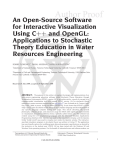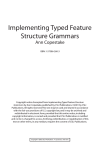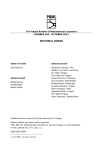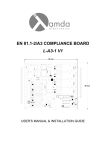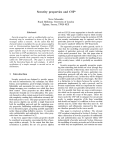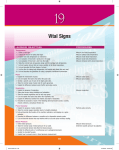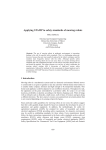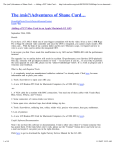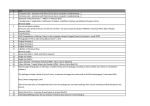Download Filoglossia+
Transcript
CALICO Journal, 25 (1) Software Review Filoglossia+ Reviewed by MARIA PANTELIA University of California, Irvine PRODUCT AT A GLANCE Product Type: Interactive language learning software Language: Greek Level: Beginners Activities Dialogues, dialogue repetition, comprehension exercises, recording facilities, phonetic transcription, vocabulary, reading and listening comprehension, spelling and grammar exercises, bilingual dictionary, culture presentations Media Format: CD-ROM (4 Disks) Operating Systems: Windows 98/Me/2000/XP Hardware Requirements: Pentium 200MHz+; 32 MB RAM; 10 MB of hard disk space; VGA+ video; MPC compliant sound card (with external microphone); 16X CD-ROM drive Documentation: ReadMe files included in CD-ROM directory; help Menu in the program Price: Single-user copy, 20 Euros (~$US 35.00) per CD-ROM; 10-30% discount for multiple copy orders (contact producer for details); chapters 1-10 are available online free of charge at http://www.xanthi.ilsp.gr/filog/ GENERAL DESCRIPTION The program Filoglossia+ ‘Love for Language’ was developed by the Institute for Language and Speech Processing (ILSP), a state-funded research organization based in Athens, Greece and operating since 1991 under the auspices of the Greek Ministry of Development (General Secretariat of Research and Technology). ILSP’s website (http://www.ilsp.gr) provides a detailed description of the organization, its goals, and its various research endeavors. The Filoglossia+ CALICO Journal, 25 (1), p-p 137-146. © 2007 CALICO Journal 137 CALICO Journal, 25 (1) Software Review suite is a series of four educational multimedia CD-ROMs designed for beginners with little or no previous knowledge of Modern Greek. The first two CD-ROMs are freely available online (http://www.xanthi.ilsp.gr/filog/). The web version retains the majority of the pedagogical and design characteristics of the CD-ROM series but includes only a subset of the material of the CD-ROM version. This review was based on the (commercial) CD-ROM version.1 Summary of Features The Filoglossia+ program is based on the communicative approach and focuses on comprehension of both oral and written speech. English translation is available throughout the program, but users are encouraged to use Greek in order to acquire communicative efficiency. Dialogues and exercises are based on everyday life situations. The program is divided into twenty chapters, five on each disk. Chapter One is an overview of the Greek alphabet, gender, definite article, and punctuation while Chapter Twenty is meant as a review. Overall, the program covers the basic functions of a typical first-year college modern Greek curriculum. Each chapter consists of four main language sections: Dialogue (supported by video), Vocabulary (Basic and Additional), Grammar, and Useful Phrases, all appearing at the bottom part of each screen (see Figure 1). Figure 1 Four Main Language Sections 138 CALICO Journal, 25 (1) Software Review A navigation bar at the top of the page allows users to access the main menu at any time, view the contents of each chapter, go back, view the Help page (which explains the various buttons used), and exit the program. A sidebar of functional buttons is also offered enabling users to access important resources such as the bilingual dictionary, phonetic transcription, microphone, and exercises from any point in the program. All sections include exercises aimed at reinforcing comprehension, pronunciation, vocabulary, spelling, grammar, and sentence formation. Recording facilities and other multimedia language tools are incorporated in the software. Users can look up any word appearing in the program in the bilingual Greek-English dictionary and obtain the English translation, as well as examples of use. In addition, each disk contains one or more short presentations on Greek paintings, architecture, music, and so on, meant to introduce users to various aspects of Greek culture (see Figure 2). Figure 2 Various Aspects of Greek Culture 139 CALICO Journal, 25 (1) Software Review EVALUATION Technological Features The CD-ROM version of Filoglossia+ is available for the PC platform only. The program was tested on a Pentium 4 CPU (2.4GHz) with 448MB RAM running Windows XP. Each CD-ROM comes with a jacket that includes very brief installation instructions. A ReadMe file included in all the CD-ROMs contains more detailed instructions on how to install and use the program as well as trouble-shooting tips. Users have to be particularly attentive to installing the Greek keyboard. Without proper installation, the system will not recognize forms typed in Greek. They will also need to be familiar with the Greek keyboard. Overall the program presumes knowledge of Windows functions that may not be intuitive to inexperienced users. Speed was acceptable, but delays inevitably occur since most of the videos and audio tools run directly from the CD-ROM. An external microphone is required to record the user’s voice. Otherwise, installation was simple. The program installed quickly and performed well for the most part. A bug was detected though in Chapter 5 in the Grammar section (‘Personal pronouns’) that prevented the audio files from that section from playing. Technologically, Filoglossia+ is a well designed program. Users simply insert the CDROM in the appropriate drive. If the CD-ROM drive supports Windows’ auto run capability, the installation wizard guides them through the installation process. When the CD-ROM drive does not support auto run, users need to install the program from the Program Manager. Once installed, the program will recognize all 4 CD-ROMs. A CD-ROM must, however, be present in the drive for the program to operate, which may be problematic in a multistation lab environment. The program can be used directly from the disk, that is, without installation on the hard drive. In this case, some functions, such as the Help Menu, are not accessible. Navigation among the different parts of the program is easy once users become familiar with the various navigation buttons. Simultaneous access to all resources is one of the program’s strongest features. The Help File in the top navigation bar, however, is accessible only through the introductory page of the dialogue. The video segments are synchronized with the transcript. The narrative of all videos is available as Greek text and in English translation. The vocabulary, however, is not directly linked to the dictionary. Users must click on the dictionary button to look up a word. This feature may reinforce the communicative intent of Filoglossia+ but makes the use of the dictionary rather cumbersome, especially since users do not have the option to open the dictionary in a separate window. The overall sound quality was good, but users should test and adjust their audio settings before using the program; the selection and quality of photos and videos was very good. Activities (Procedure) The Filoglossia+ activities focus on listening comprehension, pronunciation, and vocabulary acquisition. There is some emphasis on writing and culture. The program uses a variety of activity types described below. Dialogues Each dialogue is first introduced with a short text which provides an outline of the story covered in each chapter (e.g., asking for and giving directions, at the post office). The dialogue is repeated in video form. English translation is always available and can be viewed side by side by clicking on the British flag button. 140 CALICO Journal, 25 (1) Software Review Users can click on any of the words or sentences of the dialogue and listen to them. A number of exercises (e.g., match words, true/false, fill in the gaps) accompany each dialogue aimed at testing and reinforcing the comprehension of materials covered in the dialogue. Vocabulary The vocabulary section is divided into basic and additional vocabulary. In the basic vocabulary section, users can listen to any yellow word of the dialogue text or the word in the context of the sentence in which it occurs. Users can also record their voice and compare it to that of a native speaker. Vocabulary exercises are also included for practice. The additional vocabulary provides words and phrases that are likely to be used within the framework of the communicative situation of each dialogue. Grammar The section on grammar introduces the most important grammatical phenomena present in the text of the dialogue further reinforced through exercises. Grammar is presented in communicative fashion with brief explanations in English when necessary (see Figure 3). Figure 3 Grammar 141 CALICO Journal, 25 (1) Software Review Useful phrases This section offers short dialogues on topics related to the particular situation covered in the chapter. These dialogues point out variations due to grammar, vocabulary, or social context (e.g., friendly vs. formal). Exercises Each section outlined above includes exercises aimed at reinforcing comprehension, pronunciation, vocabulary, spelling, grammar and sentence formation. Multimedia tools Recording facilities and other multimedia language tools are incorporated in the software. For example, users can record their voice and compare it to the pronunciation of a native speaker. They can also see the phonetic transcription and listen to the pronunciation of any Greek word by voice synthesis. The quality of the voice synthesis is acceptable but certainly not indistinguishable from a human voice. The program has a fairly large but still circumscribed text basis which could have been recorded with real voice. Dictionary The bilingual dictionary can be accessed at any point through the sidebar. It contains the dictionary form of all words used in Filoglossia+, the translation, grammatical information, and examples of use (see Figure 4). Figure 4 Dictionary 142 CALICO Journal, 25 (1) Software Review Documentation (online help, printed materials) The package contained no detailed user manual. However a more detailed ReadMe file is included in each CD-ROM directory, outlining the program and its use. If the user’s drive has the auto run function, this file can be accessed by right-clicking on Properties/Explore in the Windows menu. Inexperienced users may not immediately realize the usefulness of the ReadMe file or know how to find it. It would be helpful to include a detailed user manual with the CD-ROM. Teacher Fit (Approach) The Filoglossia+ program is based on the communicative approach in which users learn to “communicate” effectively without thinking about the grammar. Grammatical structures and syntactic functions are also treated in a communicative context. The program reinforces communication by offering students an opportunity to practice everyday speech. Sufficient attention is paid to dialogue building, sentence construction, and contextual use of language. The lessons and related activities are designed to develop all four language skills (listening, speaking, reading, and, to a lesser extent, writing). Pronunciation and dialogue drills enable users to practice pronunciation, listening, and speaking, while some grammar drills allow them to work with written forms. Writing is, for the most part, limited to fill-in-the-blank exercises. This type of exercise provides learners with the opportunity to type what they hear and promotes acquisition of the written form of a word or expression. There is, however, no dictation or meaningful composition, for example, writing a postcard, leaving a note for a friend, and so on or grammar drills that would allow users to work on their writing skills. Practice of reading skills at the word and sentence level is indirectly achieved through working on most of the dialogues and drills. In addition, there are a good number of exercises that focus on vocabulary learning. Grammar is given a less central focus as simply one component part of the instructional materials. The program could be used in the classroom as a supplementary resource to improve listening comprehension and vocabulary acquisition. Considering, however, that it is not complementary to any standard Greek textbook series, instructors may not be able to use it as a regular course resource. The program is fixed, namely, it cannot be modified by the instructor to fit the needs of a particular class although instructors could assign particular sections and direct the students to pertinent materials. Exercises are carefully crafted though response handling is minimal. A correct answer is rewarded by a voice confirming that the answer was correct or by an instructor avatar who appears at the bottom of the page at the successful completion of a particular exercise. Students can repeat the exercises as many times as they wish and obtain a list with the correct answers by clicking on a Key button, but there is no feedback or indication of the nature of the error. Answer handling is restricted to exact string matching, with no allowance for upper/lower case, accents, punctuation, or even extraneous spaces. There is also no ability to save students’ progress. Voice recordings are not saved, nor are any of the grammatical exercises. The software provides authentic language input via video which features native speakers who make use of colloquial, sociolinguistically appropriate language. It expects learners to listen carefully, understand, and repeat what native speakers of Greek would say in particular situations. The program does not claim to follow a sociocultural approach in which the language is learned as part of the culture. It does, however, make an effort to introduce learners 143 CALICO Journal, 25 (1) Software Review to selective aspects of Greek culture and daily life mostly through additional vocabulary and various cultural presentations. The short dialogues focus on changes from a formal form of address to an informal one during a conversation, but there is little or no age or social status variation in the dialogue characters. The cultural presentations included in the four CD-ROMs could be useful in stimulating student interest and serve as a starting point for class discussion, but they are rather narrow in content and scope. For example, one has to wonder why an overview of neoclassical buildings in Athens should be privileged as an important aspect of Greek culture in a course addressed to beginners. The program could be described as learner centered and learner controlled. Although it is structured in consecutively numbered chapters, students always have the option to skip various sections and exercises, go to the dictionary, or listen and repeat a word or a sentence as many times as they wish. The short dialogues, with their numerous variations, facilitate understanding and provide additional vocabulary. Learner Fit (Design) The Filoglossia+ program is aimed at beginners or near beginners. Its developers do not explicitly promote the program as a self-directed study but have gone to great lengths to incorporate a variety of exercises and resources to assist learners. The program does not come as an accompaniment to a textbook and does not contain a manual for grammar and syntax. The materials covered in each chapter are rather extensive, but the exercises provide only a few examples for practice. Given the complexity of the Greek language, it is doubtful that average users will be able to learn Greek without some additional instructional resources. Users with prior experience in Greek may be able to use Filoglossia+ without an instructor as a review tool. The program does an excellent job in listening comprehension, overall understanding of Greek, and vocabulary acquisition. Learners can listen as many times as they want, record their voices, or practice with additional vocabulary and useful expressions. However, feedback within the program is limited to the indication of correctness or incorrectness by the “instructors.” Users have the option of seeing the right answers, but additional responses or suggestions are not possible when students fail to provide the correct answer. Because of the abundance of multimedia materials and the fact that almost all the exercises include audio capability, this software accommodates both visual and audio learners. The dialogues and overall style would appeal more to adults. Linguistic Accuracy The program is grammatically sound as far as the Greek is concerned. No typos or grammatical errors were detected in the Greek, a clear sign of the time and care invested in designing and executing the software. Modern Greek is a highly inflectional language with a long history of development. As a result, several words, especially verbs and nouns have, over time, acquired multiple grammatical forms. The developers of Filoglossia+ have made the decision to introduce and consistently use certain grammatical forms, the ones they consider most widely used. Even if one disagrees with their particular choices, their decision is pedagogically sound and wise for a program addressed to beginners. The only inconsistency noticed was in the spelling of the word ανηψιά/ανιψιά. Both spellings of the form are used at different parts of the program and listed in the dictionary. 144 CALICO Journal, 25 (1) Software Review Unlike the Greek, the English translations are not always literal. It appears that the developers have opted for translations that are closer to the Greek texts at the expense of the naturalness (and sometimes accuracy) of their English equivalents. For example, in Chapter 17, Useful Expressions: στο ταμείο για τα δέματα δίπλα is translated ‘You’ll go to the counter for the packages, beside’ instead of ‘You will go to the next counter for the packages.’ A few typos and mistakes have also been detected: Chapter 3: Useful Expressions: the English translation ‘Enjoy your staying’ should be ‘Enjoy your stay.’ Chapter 4: Grammar/Neuter Cases. ‘Here follow some sentences’ would not normally be said in English. Chapter 4: Grammar/Subjunctive Mood. A definite article is missing in the sentence: ‘the subjunctive ... has the endings of the present tense in indicative mood.” Chapter 4: Grammar/Exercise 2. A definite article is missing: ‘Using the neuter noun in plural … .’ Chapter 5: Grammar/Masculine nouns in ος … stressed in the last syllable from the end should be “stressed on the last syllable” and “from the end” should be deleted. SUMMARY The Filoglossia+ program is well designed multimedia language software with many appealing features, such as authentic and motivating dialogues, interactive audio and video capabilities, and well thought out exercises. It can be useful as a supplement to a program of formal instruction or as a tool for self-study for motivated and experienced users who wish to review the language but do not have the opportunity to study it in a traditional academic environment. Given the lack of feedback to students, the program may not work for everyone as stand-alone software unsupported by classroom instruction. Considering the paucity of existing interactive software for learning Modern Greek, however, a program as extensive and reasonably priced as Filoglossia+ is a welcome addition. The program’s limitation to the Windows platform may no longer be a shortcoming once Mac users have the ability to run Windows software on new Intel-based Apple computers. Aside from the question of platform, the availability of the web version, even limited to the first ten chapters, has the potential of reaching a wider audience. Users of Filoglossia+ will be encouraged to learn that, according to the developers, there are plans to move the entire program to the online environment. SCALED RATING (1 low-5 high) Implementation Possibilities: 4 Pedagogical Features: 4 Linguistic Accuracy: 4 Sociocultural Representations: 4.5 145 CALICO Journal, 25 (1) Software Review Use of Computer Capabilities: 4 Ease of Use: 5 Overall Evaluation: 4 Value for Money: 5 NOTE 1 For a comparison of the two versions, see Hatzigeorgiu, N., Sidiropoulos, N., & Charalabopoulou, F. Learning Modern Greek on the web: The ‘Filoglossia’ software. In Proceeding Web-based Education–2005 (461-114) (http://www.actapress.com/Content_Of_Proceeding. aspx?ProceedingID=292). PRODUCER’S CONTACT INFORMATION Institute for Language and Speech Processing Artemidos 6 & Epidavrou 151 25 Paradisos Amarousiou Athens Greece Phone: 30 210 6875 300 Fax: 30 210 6854 270 Email: [email protected] Web: http://www.ilsp.gr REVIEWER’S BIODATA Maria Pantelia is Professor of Classics and Director of the Thesaurus Linguae Graecae® at the University of California, Irvine. REVIEWER’S CONTACT INFORMATION Maria Pantelia TLG Project University of California, Irvine 3450 Berkeley Place Irvine, CA 92697-5550 Phone: 949 824 7709 Fax: 949 824 8434 Email: [email protected] 146










